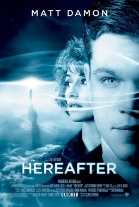Hereafter
|  About halfway through Clint Eastwood’s Hereafter there is an extended passage of great emotional resonance between George Lonegan (Matt Damon), a psychic who is trying to run away from his gift/curse, and Melanie (Bryce Dallas Howard), a woman he has met at a night-school cooking class. They are both clearly lost souls who are simultaneously trying to protect themselves and find their footing in the world, and there is a beautiful sequence of guarded revelation and growing connection as they take turns being blindfolded and fed a spoonful of food by the other, the goal being to describe the taste and texture to improve their palettes. This leads to their going back to his apartment to make dinner, and an unexpected phone message forces George to reveal his former occupation, which naturally piques Melanie’s interest. She asks for a reading, but he resists, noting that sometimes knowing too much about another person is not a good thing. She persists, and he finally gives in, despite his fear that she will be unable to handle his ability to commune with those close to her who have died and moved into the afterlife. About halfway through Clint Eastwood’s Hereafter there is an extended passage of great emotional resonance between George Lonegan (Matt Damon), a psychic who is trying to run away from his gift/curse, and Melanie (Bryce Dallas Howard), a woman he has met at a night-school cooking class. They are both clearly lost souls who are simultaneously trying to protect themselves and find their footing in the world, and there is a beautiful sequence of guarded revelation and growing connection as they take turns being blindfolded and fed a spoonful of food by the other, the goal being to describe the taste and texture to improve their palettes. This leads to their going back to his apartment to make dinner, and an unexpected phone message forces George to reveal his former occupation, which naturally piques Melanie’s interest. She asks for a reading, but he resists, noting that sometimes knowing too much about another person is not a good thing. She persists, and he finally gives in, despite his fear that she will be unable to handle his ability to commune with those close to her who have died and moved into the afterlife.It’s a beautifully modulated sequence in terms of both Damon and Howard’s performances and Eastwood’s direction. It conveys a sense of tenderness and the fragility of human connection, that wonderful, terrible quality that can take us from fulfillment to tragedy in the blink of an eye. And, had the film maintained some semblance of that effectiveness for its entire duration, it might have been a deeply moving, potentially transcendent experience. Unfortunately, that story is just one part (actually, one part of one part) of an awkwardly trifurcated narrative involving a trio of characters who are all somehow close to death and whose paths are preordained to cross. The screenplay by Peter Morgan (Frost/Nixon, The Queen) feels a bit too much like an exercise, rather than a finished product, especially in the way the climatic interweaving of the narrative strands feels profoundly anticlimatic, delivering a modicum of emotional payoff but little else. Compared to the story involving Damon’s character, the other two strands are decidedly less involving. One involves a famous French television journalist named Marie Lelay (Cécile de France) who has a near-death experience when the 2004 Indian Ocean tsunami hits the village where she is vacationing with her producer-boyfriend (Thierry Neuvic). She is revived after drowning, but she can’t quite shake the visions she had while hanging between life and death, which she decides to pour into a book. The third story follows 11-year-old British twins named Marcus and Jason (Frankie and George McLaren) who work together to care for their alcoholic mother (Lyndsey Marshall) before one of them is killed in an accident, thus leaving the other alone in the world for the first time in his life. The fact that these other two stories don’t work nearly as well is a result of several factors, the main one being that they never quite build a real sense of emotional depth. There is something slightly scattered and fragmented about them, where we recognize what is happening, but never really feel it. It doesn’t help that twins narrative is hindered by the fact that Eastwood directed Frankie and George McLaren to act creepy most of the time, which undermines any sense of involvement with them. Thematically speaking, Hereafter never coheres, which means that any emotional unevenness cannot be justified by thematic consistency. The big picture is obviously the question of life after death, something the film never questions given that Damon’s character is presented as the real deal at all times; there is no explanation for the knowledge he obtains when he “connects” with someone other than his being able to hear the voices of the recently deceased. There are attempts to wrap current crises into the big picture, whether it be fears of terrorism or fears of natural disaster or fears of massive conspiracies designed to keep us all in the dark. Those attempts are generally fumbling, which means that the film never has anything deeper to convey than the idea that there is a hereafter and that the characters in the film are somehow touched by it and are ultimately brought together, if only fleetingly, by their belief in it. In other words, there is a lot of narrative work expended for surprisingly shallow results. Copyright ©2010 James Kendrick Thoughts? E-mail James Kendrick All images copyright © Warner Bros. |
Overall Rating: 
 (2)
(2)


